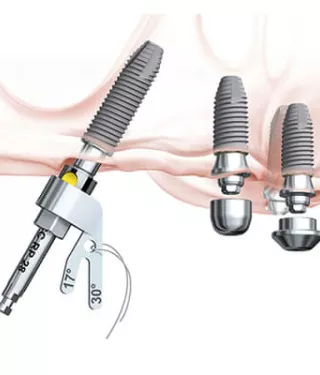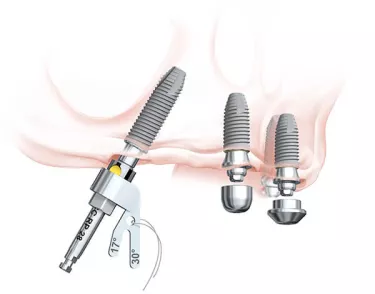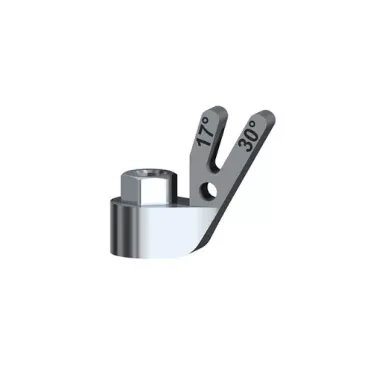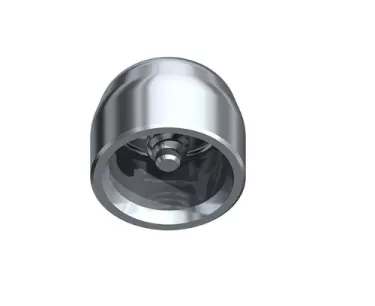
Taking the All-on-4® treatment concept to the next level
Now, for ease, speed and efficiency, the Multi-unit Aligning Instrument and Titanium Multi-unit Healing Cap represent the latest step forward in the All-on-4® treatment concept.
A revolution when it was first introduced almost two decades ago,1 the multiple benefits of the All-on-4® treatment concept are now well proven.2 A key enabler of the concept today is the Multi-unit Abutment, a catalyst of the trend for restoring multiple teeth using tilted implant placement. First developed by Nobel Biocare in 2000, and a first in the industry at the time, the technology continues to evolve.
The introduction of the Multi-unit Abutment Plus in 2016 supported a significant reduction in chair time for the All-on-4® treatment concept. This evolution of the original Multi-unit Abutment eliminates the need for screw fixation during try-in and adjustment of the provisional prosthesis.
Now, for ease, speed and efficiency, the Multi-unit Aligning Instrument and Titanium Multi-unit Healing Cap represent the latest step forward in the All-on-4® treatment concept.
Three angulations in one
Selecting a less-than-optimal implant position for the seating of the Multi-unit Abutment, or the wrong Multi-unit Abutment, can cause significant inconvenience for both clinician and patient during subsequent steps of the restorative workflow. When this happens, the restorative technician must potentially remove and then re-seat four or more abutments, costing time and money that could have been avoided.
For ease, speed and efficiency in choosing the correct Multi-unit Abutment rotational position and angulation, Nobel Biocare has designed the Multi-unit Aligning Instrument. This latest innovation has been designed to reduce chair time by indicating three different angulations using one tool. The instrument makes it easy to identify the angulation of the most-suitable Multi-unit Abutment and the rotational position of the implant, helping to optimize the final abutment position and prosthetic design. This is further helped by easy-to-see laser-etched markings. Clinicians can easily identify the screw-hole trajectory to avoid facially protruding screws and optimize prosthesis design.
Compatible with existing implant drivers and the manual torque wrench, the new and reusable aligning instrument complements the Nobel Biocare product range in facilitating straightforward placement of the abutment.
The instrument is particularly beneficial for the All-on-4® treatment concept procedure, both for improving the speed and efficiency of experienced clinicians, and in supporting new clinicians in making the correct choice of Multi-unit Abutment and rotational position of the implant.
Multi-unit healing caps: an individualized approach to soft tissue healing
The Titanium Multi-unit Healing Cap assortment is a new facilitator for the placement of the provisional prosthesis. Designed to help individualized treatment, this newly expanded portfolio of healing caps provides clinicians with a choice of dimensions and designs to suit the thickness of the soft tissue, to gain improved access to the Multi-unit Abutment.
The new healing caps have been developed with ease of use in mind, helped by a new internal design. The inside of the cap is only partially threaded, with 0.3 mm of smooth surface at the tip. This makes it easy to slip into position and place onto the abutment. For strength and ease of placement, the new caps are one-piece components made of titanium.
The external design features special markings to facilitate the visual identification of healing cap heights for both lab and clinician, and the caps are conveniently delivered ready to use in packs of two. It’s important to note that the caps are for single use only. There are a variety of reasons for avoiding reuse. For example, research has shown that 99% of healing abutments may show protein contamination at one or more sites following cleaning and sterilization.3 What’s more, whichever sterilization method is used, the pristine surface of the original abutment will never be recovered.
Next generation of the All-on-4® treatment concept
The All-on-4® treatment concept is now accepted as an industry standard. Nobel Biocare’s ongoing development of the concept and associated technologies doesn’t just help experienced surgeons in offering their expertise faster, but supports the next generation of All-on-4® treatment concept practitioners.
Not all featured products may be regulatory cleared/released for sale in all markets. Please contact the local Nobel Biocare sales office for current product assortment and availability.
References
1. Malo P, Rangert B, Nobre M. “All-on-Four” immediate-function concept with Branemark System implants for completely edentulous mandibles: a retrospective clinical study. Clin Implant Dent Relat Res 2003;5 (Suppl 1):2–9.
2. Patzelt SB, Bahat O, Reynolds MA, Strub JR. The all-on-four treatment concept: a systematic review. Clin Implant Dent Relat Res 2014;16(6):836–855.
Lopes A, Maló P, de Araújo Nobre M, Sanchez-Fernández E. The NobelGuide® All-on-4® treatment concept for rehabilitation of edentulous jaws: a prospective report on medium- and long-term outcomes. Clin Implant Dent Relat Res 2015;17(Suppl 2):e406–416.
Maló P, de Araújo Nobre M, Lopes A, Ferro A, Gravito I. All-on-4® treatment concept for the rehabilitation of the completely edentulous mandible: a 7-year clinical and 5-year radiographic retrospective case series with risk assessment for implant failure and marginal bone level. Clin Implant Dent Relat Res 2015;17(Suppl 2):e531–41.
Mozzati M, Arata V, Gallesio G, Mussano F, Carossa S. Immediate postextractive dental implant placement with immediate loading on four implants for mandibular full-arch rehabilitation: a retrospective analysis. Clin Implant Dent Relat Res 2013;15(3):332–340.
Weinstein R, Agliardi E, Fabbro MD, Romeo D, Francetti L. Immediate rehabilitation of the extremely atrophic mandible with fixed full-prosthesis supported by four implants. Clin Implant Dent Relat Res 2012;14(3):434–441.
Maló P, de Araújo Nobre M, Lopes A, Ferro A, Gravito I. Complete edentulous rehabilitation using an immediate function protocol and an implant design featuring a straight body, anodically oxidized surface, and narrow tip with engaging threads extending to the apex of the implant: a 5-year retrospective clinical study. Int J Oral Maxillofac Implants 2016;31(1):153–161.
3. Wadhwani C, Schonnenbaum TR, Audia F, Chung KH. In-vitro study of the contamination remaining on used healing abutments after cleaning and sterilizing in dental practice. Clin Implant Dent Relat Res 2016;18(6):1069–1074.


